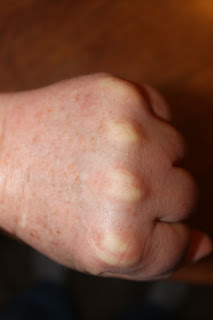The point of the pictures of my hands is because it is a good way to gauge the condition of an animal. Feel the ribs and if they feel like the joints across your hand with your fingers out flat ( you can feel them but they are well covered), then the animal is probably pretty good. If it is hard to feel the ribs, cut back on the feed. Your just producing fat on the animal.
If it feels like your joints across the top of your hand with your hand closed, he's under fed. The three goats in the pen had NO>>>> covering just skin and the ribs felt very sharp and pointed.
Don't be misled by fat bellies. You don't look at belly to gauge how well an animal is fed. It can be distended, just like the starving kids in Africa. It can be large and the ribs sticking out meaning the animal is really, really wormy.
It can also mean poor stomach muscles. We once had a sheep our son took to fair that had a BIG belly. He weighed in too large to sell as a market lamb without the judges approval. We asked for her judgement knowing she'd be shocked. She stepped up to him in the show ring, felt his muscle and you could see the extreme surprise on her face. He the Hulk with a fat belly. Muscles bulging everywhere but his belly.
One gentlemen, admitted he couldn't believe we, who the judges had often complimented for our ability to finish a market animal to perfection, would bring something like this to fair for judging. This competitor had to slip into the pen and feel him. He was shocked.
Our son's wether was not only, not over weight, he was in superb conditioning. The judge encouraged the crowd to come and feel as the first words out of her mouth were, "It's hard to get past the belly but this animal is in superb conditioning."
Believe me, we thought about a major diet but the ribs were already on the verge of tipping toward the skinny side. Exercises directed toward the stomach area were a wash. You've got to have muscle to build. So we took the lamb and made him into the best he could be. Pretty impressive if it hadn't of been for that belly.
This lamb further taught us that every animal is different. Some are easy keeper like me. Little feed, lots of covering. Others you have to put on a high fat diet to keep them looking good.
Animal husbandry is about knowledge, knowledge of where a species carries excess fat like in cattle which is around the tail head and on the neck in front of the shoulders to name a couple spots.
It's a gift, some have it and some don't but all can gave a level of competence.
And now I've got to go and take a peek at Chicory. A friend called a while ago and thought she was in early labor. She's got me worried. I made an eighty mile dash yesterday for supplies. She's got a hard, large udder but the teats aren't filling. And this doe has a beautiful medial ligament on her udder but her bag is round like a ball, not nice compartmentalization. She's also large, at least triplet looking. And she's acted like she will deliver a few days early. Chicory never delivers early.
So I bought lamb replacer (powdered milk), electrolytes, powdered colostrum, mastitis medicine - though her udder doesn't feel hot, Milk of Magnesia for softening of the udder, and pro-biotics. I've always got antibiotics in the refrigerator that always go bad before they are used. just in case I need it. All this because at night the stores aren't open and living in the toolies where we do, it's a long ways to the nearest livestock supply store. Two hours before you can be there and back to deal with the crisis. So I say it's better to be prepared than panicked and in a mess.
This little tidbit was in the Tri-State New, interesting and worth thinking about especially this time of year.
It's believed by feeding in the evening, the majority of cows will give birth during daylight hours, easing human labor needs and boosting calf survival, said Adele Harty, SDSU Extension cow/calf field specialist, during a recent iGrow Radio Network interview.
"If we're feeding in the evening, more will calve during the daytime. This is easier on the calves because they get the sunlight, they're going to be more active, more likely to get up to nurse, get that colostrum in the first hours of life and get a better start," Harty said.



No comments:
Post a Comment